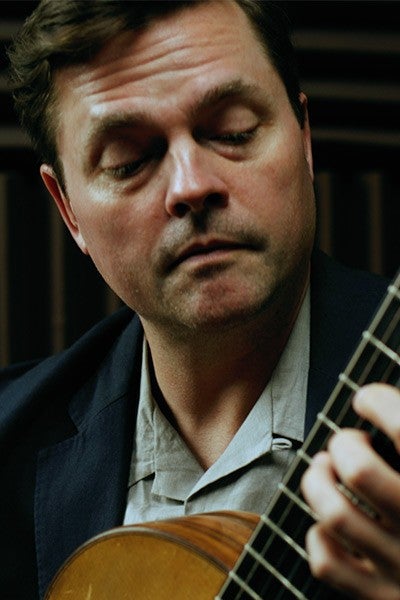Bret Williams


About Bret
“The Music of Bret Williams has it all: fantastic playing, great recording quality, and compositions that will please classical, jazz, and general listeners alike.” (ThisIsClassicalGuitar.com). Classical Guitar Magazine profiled his work as “alluring” and “accomplished.” Tony Morris of NPR’s Classical Guitar Alive! praised his music for it’s “energetic, warm and polished sound.” Soundboard Magazine credits him with “wonderful precision.”
Williams studied with Terry Mills from the University of the Pacific. He went on to receive his Bachelors of Music from the University of Texas at Austin while under the instruction of Adam Holzman. After receiving numerous accolades, he continued his studies in New York City at the Mannes School. There he worked with Fred Hand, Michael Newman, and Terry Chaplain. Following a robust concert schedule and multiple recordings, he was diagnosed with focal dystonia, restricting movement in the right hand, in 2012. He continues to work with professionals and colleagues on the issue, and since has developed a new style of playing and composition for the instrument.
Soon after receiving his Masters Degree, he formed La Vita Williams Guitar Duo with Giacomo La Vita. He went on to record an album featuring various compositions for solo guitar and another featuring works he wrote for quartet (clarinet, violin, guitar, bass). His most recent release is Seven Original Pieces for Solo Guitar.
Notable concert appearances include the Brooklyn Academy of Music, the Kimmel Center for Performing Arts, St. Peter's Church, The Riverside Church, the Shandelee Music Festival, and the Mannes Guitar Symposium. He has taught at Concordia College, Lucy Moses School, The School at Columbia University, Hostos Community College, Turtle Bay Music School, and has been instructing at Rodeph Shalom School for 14 years. He served on faculty as a general music teacher at the South Bronx Early College Academy.
Whether dealing with classical music or rock, the student must be required to formulate an objective on as regular a basis as possible. I call this Goal Oriented Practice. Rather than telling someone to practice for a given amount of time, a decision must be made by the student, with the aid of the teacher, as to what needs to be accomplished. Making the student create their own goal shifts the responsibility in their direction and brings us closer to the creation of a true artist. Teaching classical music promotes an awareness that can't be found anywhere else. There is certainly a place for popular art, and it is not in short supply. Exposing children and adults to our music may be their only access to art that is not trying to sell them something. If they go far enough, they will find music that is independent of association and stands on its own merit. When a student is not only exposed to this concept, but puts it into action, the teacher has promoted the ability to think independently.
- Sponsored by:
- D’Addario Strings
- SavageClassical.com
- nkoda.com
- Host, Classical Guitar Insider
- Host, Music History Podcast
B.M. - University of Texas at Austin M.M. - Mannes College of Music at The New School